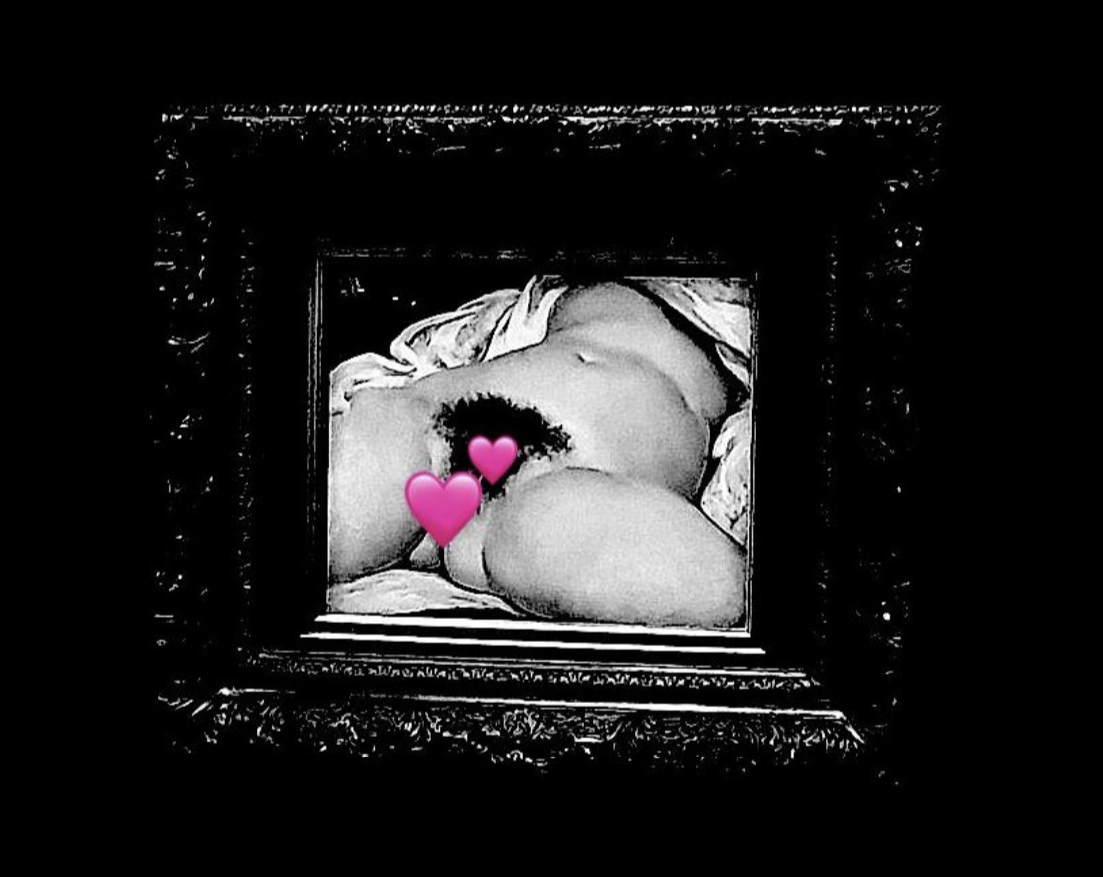The Realist is a Dreaming Boy:
Francis Whorrall-Campbell’s experimental text responding to FACET2023
Francis Whorrall-Campbell’s experimental text responding to FACET
2023

Image composed by Francis Whorrall-Campbell to accompany this text.
‘Art is liberty itself, recreating under its guise and for its ownglorification, the phenomentality of things, executing (pardontheword) variations uponthe concrete theme ofnature.’
Pierre-Joseph Proudhonin J. H. Rubin, Realism and Social Vision
‘I’ve met angels / I’ve touched creations.’
Tracy Chapman, Heaven’s Here On Earth
>Pierre-Joseph Proudhonin J. H. Rubin, Realism and Social Vision
‘I’ve met angels / I’ve touched creations.’
Tracy Chapman, Heaven’s Here On Earth
In the light of several tastefully placed candles, the Realist lies on her bed, attempting todream. She is bored.
>
When was she last able to make little fancies of her life? She thought of Proudhon and thedesire to use art to transform reality by brutally confronting it. She’d always considered
herself an anarchist, but maybe she was just an anxious avoidant. Everyone was so abjectsince the second millennium; no wonder people were re-running away into the 1990s. They’dovershot the end of history onto a blank page and people all over were finding it impossibleto dream new dreams. Without familiar patterns, what tools did people have to confrontreality? The Realist suspected, however, that this page was not blank, but covered in an olderscript – so faded as to make it invisible to modern eyes.
Written there were the rules of an earlier century, one she roughly identified as correspondingto the so-called Long Nineteenth Century. The Victorians called and they want theirobscenity laws back: only this was before the popularization of the telephone, so they wrote aletter instead. The Realist sets about deciphering this message and producing a response,believing that here she might discover the method to transform her reality. If she couldleapfrog contemporary fashions and fascisms, and return to the origin of the (real) world,perhaps she could reply to this letter.
>
Swaddled in the stench of BYREDO Ambre Japonais, everything that had been holding herin time begins to push back, harder. At what point she started to confuse the commodifiedsignifiers – cunty archive corsetry, homesteading TikToks, little women on Hausmannifiedstreets and dupes of Sally Rooney – for the real contours of the world, she can’t tell. TheRealist lies catatonic, the inverse of a sleepwalker. A storm of images threatens to overtakeher and dissolve her material body into pure, dematerialized value. And so, pixelated into anexchangeable symbol, the Realist begins her investigation.
>
The Realist started by looking for tools which suggested particularly transformativepossibilities. She bought a pen, a paintbrush, a sewing machine, a chisel, a printing press, asoldering iron, a liberal arts education, and some disposable syringes. But nothing, when heldin her ghostly fist, was immune to contamination by her insufficiency. Possible worldsslipped through her fingers like sand in an egg-timer, each grain bringing her closer tobecoming hard-boiled. So she turned the timer over, reversing the flow and bringing her backto a crackable state.
>
In 1855 she made a painting of her room, as delicately fleshed out as she could muster. Stillthere was something wrong about the description. She’d been faithful, painting the darkcorners untouched by candlelight a deep black. But on the canvas these areas surgedforwards, the volumetric opposite of her studio’s cosy recesses. They didn’t fold her body in,like a weighted blanket above a mattresses’ familiar divots, but sent her starting – a shadowin the night she was afraid of colliding with, even more than the naked model in thepainting’s centre.
>
In 1921 she tried her hand at sculpture. She went to bed with a young boy who carriedSwann’s Way like a designer purse. When she awoke, she found upon her pillow long curls
ensconcing an admirable female face. The unexpected encounter with an unconsciousGalatea terrified her and so she ran away out of the room and back to the streets.
>
Between 1845 and 1867 she didn’t make much besides profit for others. She dwelt onproperty she did not own, obliged to grind the phenomenological husk of her life intocomestible pieces on the tech-lord Mark Bezos’s data mill – a recalcitrant value pumpinflating the phallic glass and steel totems of the 1%. To afford her schooling on Marx’spolitical economy, she worked minimum-hour contracts in warehouses in the North ofEngland. They were vast labyrinths, built flat and of less shiny but fundamentally the samestuff as the Big Dicks’, around which the hands ran, following the boxes of sold goods. Thecardboard burned her eczema and the vibrations from her location-tracking wristbandreminded her that she dropped more than skin cells into the open hands of her employer whenshe’d handed over her passport.
>
In 2024 she discovered the power of accessory and resolved to lose herself inphantasmagoria. She plucked from the disinterested gloss of a fashion rag, a clear Perspexbustle – Casey Cadwallader for Thierry Mugler – worn to hold up cut-outs from a scoopwaisted hobble skirt. She took small rejuvenating steps across the apartment’s parquet floors,enjoying the bash of pelvis against plastic. The fantasy silhouette came with friction and sherealised that dreams being born felt very much like nothing at all. It was only when shelooked in the mirror that she saw she was in the wrong delusion and in the scramble todisrobe, she tripped and fell, cracking a nail on her clocky hip bone.
>
1831 was a year of rest and relaxation, and with more energy she managed to write both anovel and short story, and get them published. Her agent had described them across a widewhite table to two executives as ‘realism with fantasy elements’, which pissed her offbecause she’d not licensed him to comment in such a way that made her his wild ass, nakedlybucking on carpet tiles. Mercurial was her preferred description, because it was volatile andshapeshifting and you couldn’t believe it was real when your teacher told you about it but itwas, it was really metal. The meeting ended in a non-verbal outburst, tears stained and nearlyruined her stoic reputation but she managed to re-outfit the whole affair as Byronic. But instretching her skin across this new frame, she knew that each specimen pin marked her hidewith the painful truth that she fell short of society’s ideal man. In being Real she’d madeherself into someone else’s fantasy.
>
Twice, once in 1889 and again in 1995, she managed to hold of some black-market dog andguinea pig testicles and tried injecting their jellified insides under her skin. She didn’t havethe skill or courage to handle the large, subcutaneous needle, and the second time round ittook her the length of both Daydream and New Beginnings and two magic brownies to finallystick the sharp in.
>
It was 420 BC or 1909 and the Realist bought a large pair of scissors. All it took was one snipand she was left wondering what to do with the severed portion. Perhaps she should have alsobought some glue.
>
That night, the Realist has her first dream in a century. Divine visions were always in voguesomewhere, but what makes this one particularly special is the unique couplet of Paul Klee’sAngelus Novus with a rollerblading Mariah Carey. Mariah’s peige lips and nude eyeshadowproduces a handsome escort to Angelus’s snatched neutral garb. The two see her across thebar and like her vibe, but she resists their invitations. Even dreaming, the Realist is still firm:she doesn’t want to exist only with angels and fantasies. She wants to be really here, and thatmeans now too, suddenly she knows this is what she’s been searching for all these years.
Mariah puts her pearlescent mouth against the Realist’s ear. Two strands of hair attachthemselves to the sticky lip paint. Mariah whispers ‘often time can be bleak, dahling, so whychoose to live in it?’ Mariah’s hair, unlike the Realist’s, blows in a soft wind no one else canfeel, her tresses flowing across historical eras. ‘A storm blows in from paradise’, the angelwhispers conspiratorially, ‘the true picture of the past flits by.’ The angel’s face is turnedtoward the Realist, away from the shoreline where she had been heading before beinginterrupted by these two butterflies. Somehow Angelus is being pulled toward that Rosyfingered Dawn, that rainbow horizon, even as neither his/her/their body nor the wind areoriented in that direction.
And the Realist remembered all the time she had spent with her face pushed up against theReal, trying so hard to swallow it. To accept it, and what’s more, enjoy the taste. What a foolshe had been! Now she knew that imagination didn’t mean rejecting real life; fantasies wereborn when one rendezvoused with reality. She ground her ass against the Real instead,working her angelic fantasy into its suddenly forgiving contours. FUCK reality! Fuck being afantasy! The Realist really stuck it in there.
And as he fucked, he thought he didn’t need the glue after all. His own viscous anatomy haddone the job, slapped the final touches. He couldn’t fail, he hadn’t failed – for there are nofailed artworks, only unfinished ones.
-> Read more about the complete FACET programme HERE
about | programme | artists | space hire | archive | contact
VSSL studio, Unit 8, 50 Resolution Way. Deptford, London, UK. SE8 4AL
Contact: info@vssl-studio.org - Join our mailing list & follow our Instagram, Linkedin & Facebook.
VSSL studio logo design by Ben Normanton.
